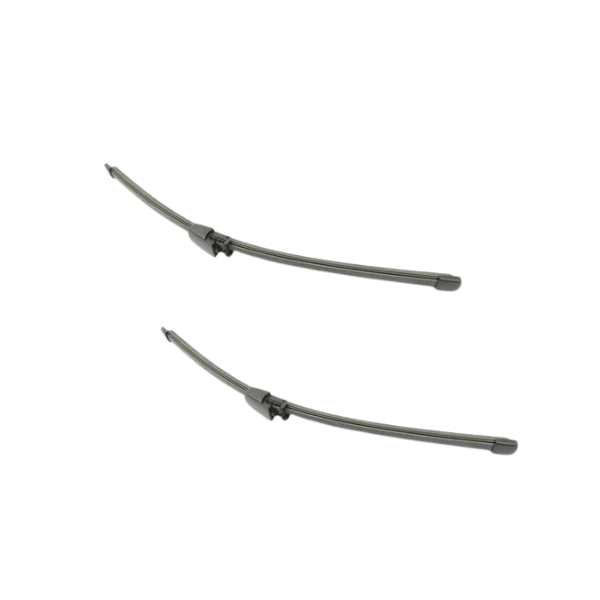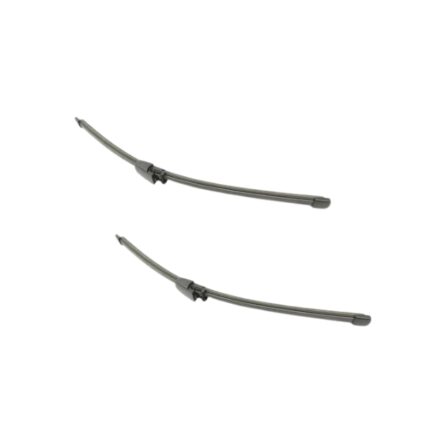Get Volkswagen / AUDI Rear Wiper Blade Size 12 Inch 6Q6955425A in Kenya
Wiper blades are an essential component of a vehicle’s safety system, playing a crucial role in maintaining visibility during adverse weather conditions such as rain, snow, and sleet. Despite their seemingly simple function, wiper blades are a marvel of engineering and material science, designed to clear the windshield efficiently and reliably. This essay delves into the history, types, design, maintenance, and technological advancements of wiper blades, illustrating their importance and evolution over time.
Types of Wiper Blades
Wiper blades come in several types, each designed to cater to different needs and vehicle specifications:
- Traditional Frame-Style Blades: These are the most common type, consisting of a metal or plastic frame that holds a rubber blade. They are affordable and widely used but can suffer from uneven pressure distribution, leading to streaking.
- Beam Blades: Made from a single piece of rubber or silicone, beam blades offer better aerodynamics and even pressure distribution. They conform more closely to the curvature of the windshield, providing superior performance in various weather conditions.
- Hybrid Blades: Combining the benefits of frame-style and beam blades, hybrid blades feature a streamlined design with a robust frame and a flexible rubber element. They offer enhanced durability and performance.
- Winter Blades: Specifically designed for cold climates, winter blades are encased in a protective rubber shell to prevent ice and snow buildup. This design ensures reliable operation in harsh weather conditions.
Benefits Of Wiper Blades
1. Enhanced Visibility
The primary benefit of wiper blades is their ability to clear rain, snow, and debris from the windshield, providing a clear view of the road ahead. This improved visibility is essential for safe driving, especially during heavy rain or snowstorms.
2. Safety
Clear visibility is directly tied to road safety. Properly functioning wiper blades help prevent accidents caused by poor visibility. They allow drivers to see other vehicles, pedestrians, and road hazards more clearly, reducing the risk of collisions.
3. Comfort and Convenience
Modern wiper blades and systems, such as rain-sensing wipers, enhance driver comfort by automatically adjusting wiper speed based on the intensity of the precipitation. This automation allows drivers to focus more on driving and less on adjusting wiper settings.
4. Protection Against Debris
Wiper blades help remove not just water, but also dirt, leaves, and other debris that can accumulate on the windshield. This keeps the windshield clean and prevents scratches that can impair visibility.
5. All-Weather Performance
Specialized wiper blades, such as winter blades, are designed to perform in specific weather conditions. Winter blades, for example, are built to withstand freezing temperatures and prevent ice buildup, ensuring reliable performance even in harsh winter conditions.
6. Durability and Longevity
High-quality wiper blades, made from advanced materials like silicone, offer greater durability and longer service life compared to traditional rubber blades. They maintain their effectiveness over a broader range of temperatures and weather conditions.
7. Aerodynamic Efficiency
Modern wiper blades are designed to reduce wind lift and noise at high speeds. This aerodynamic efficiency not only ensures better contact with the windshield but also contributes to a quieter and more comfortable driving experience.
8. Ease of Installation and Replacement
Most wiper blades are designed for easy installation and replacement. Many come with universal adapters or are designed to fit specific vehicle models, making the replacement process straightforward and hassle-free.
9. Cost-Effective Maintenance
Replacing wiper blades regularly is a cost-effective way to maintain clear visibility and ensure safe driving conditions. Compared to the potential costs associated with accidents caused by poor visibility, investing in new wiper blades is a minimal expense.
10. Aesthetic Appeal
New and well-maintained wiper blades can also enhance the overall aesthetic appeal of a vehicle. They contribute to a cleaner and more polished look, adding to the vehicle’s overall maintenance and care.
11. Technological Integration
Advancements in wiper blade technology, such as integrated heating elements and hydrophobic coatings, further improve their performance. Heated wiper blades prevent ice buildup, while hydrophobic coatings help water bead up and roll off the windshield, reducing the need for constant wiping.
Signs of worn out Wiper Blades
1. Streaking or Smearing
If your wiper blades leave streaks or smears on the windshield, it’s a clear sign that the rubber has degraded. This can be caused by cracks, tears, or hardening of the blade material, preventing it from making consistent contact with the windshield.
2. Chattering or Skipping
When wiper blades chatter or skip across the windshield, it indicates that they are not making smooth, even contact with the surface. This can be due to a misaligned blade, a bent arm, or rubber that has lost its flexibility.
3. Splitting or Cracking
Visible cracks, splits, or missing chunks in the rubber blade are obvious signs of wear and tear. Exposure to sunlight, heat, and cold can cause the rubber to deteriorate over time, leading to these visible defects.
4. Inconsistent Contact
If the wiper blades leave certain areas of the windshield untouched or clean only part of the glass, it indicates uneven contact. This can be caused by a bent wiper arm, worn-out blade material, or debris lodged in the blade.
5. Noisy Operation
Wiper blades that make excessive noise, such as squeaking or scraping sounds, are often worn out. This noise is typically caused by hardened or damaged rubber dragging across the glass.
6. Poor Performance in Heavy Rain
Worn-out wiper blades struggle to clear the windshield effectively in heavy rain. If you notice that visibility is significantly reduced during heavy precipitation, it’s a sign that your wiper blades are not performing optimally.
7. Corrosion or Damage to the Frame
Inspect the metal or plastic frame of the wiper blades. Corrosion, rust, or damage to the frame can affect the blade’s performance and alignment, leading to poor wiping action.
8. Rubber Blade Separation
In some cases, the rubber blade may start to separate from the frame, resulting in a floppy or loose blade. This separation prevents the blade from maintaining proper pressure against the windshield.
9. Misshapen Blades
Blades that have become misshapen or warped due to prolonged exposure to extreme temperatures or extended periods of non-use should be replaced. Warped blades cannot conform to the windshield’s surface, leading to inadequate wiping.
10. Age
Even if the blades appear to be in good condition, it’s generally recommended to replace them every six months to a year. Over time, exposure to the elements degrades the rubber, reducing the effectiveness of the blades.
Follow us on Facebook for more parts.




